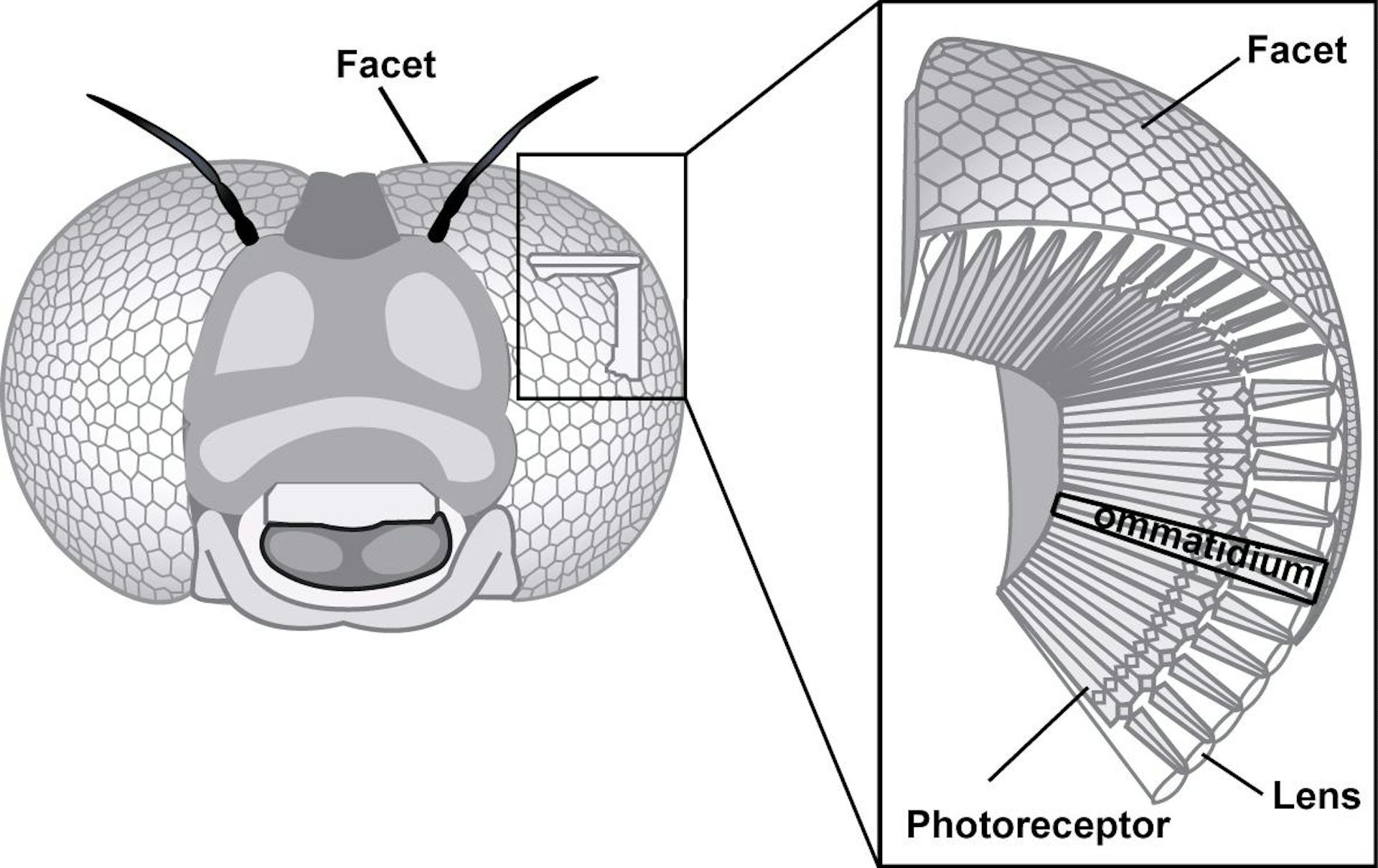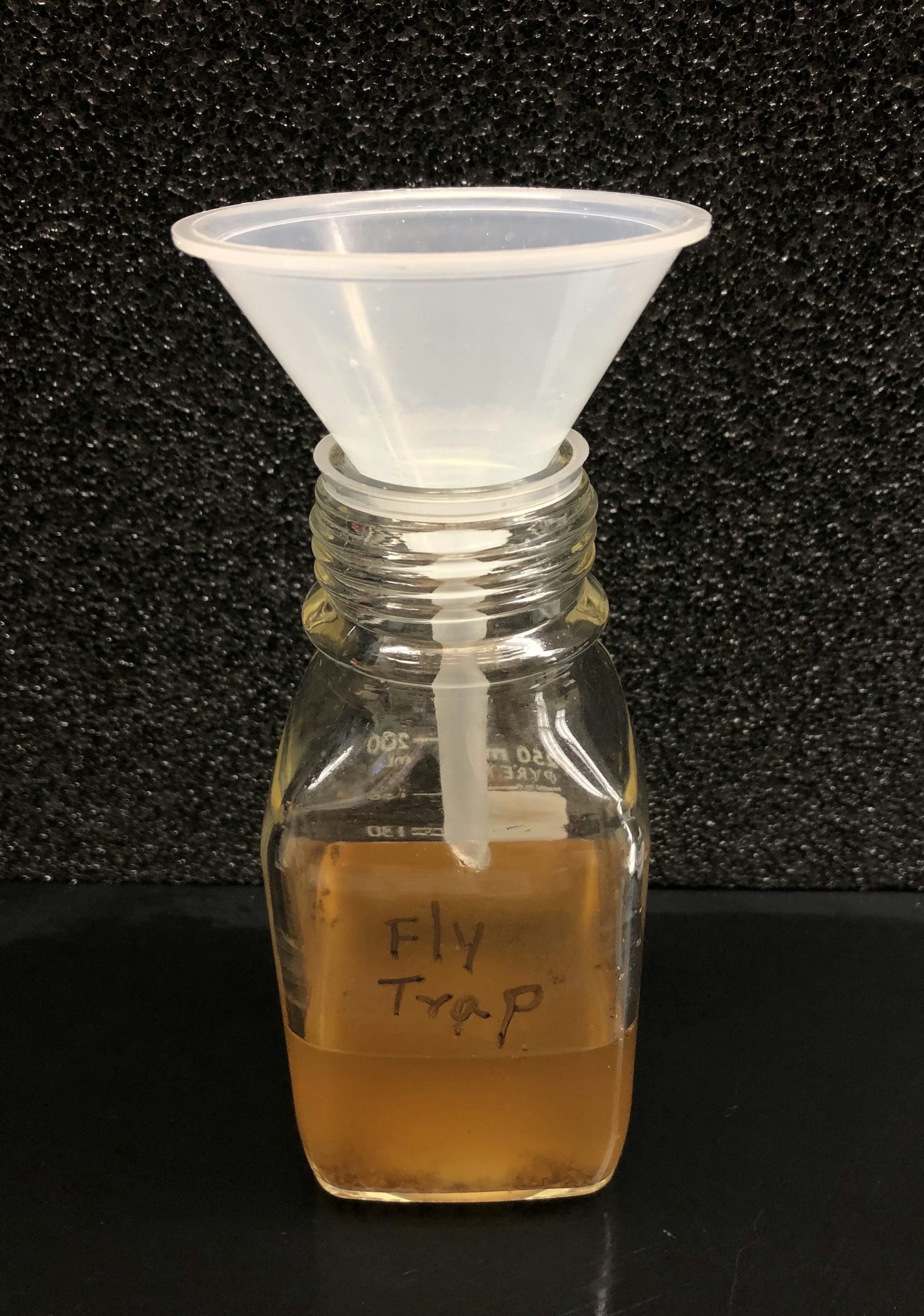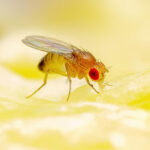How Many Eyes Do Flies have? Flies, fascinating creatures of the insect world, actually possess a unique visual system. While they might appear to have just two large eyes, the reality is far more complex and intriguing. On flyermedia.net, discover the world of aviation and insect vision, exploring the multifaceted eyes that give flies their exceptional agility and awareness. Delve into the science behind their vision, including compound eyes, photoreceptors, and fast vision.
1. What Exactly are Compound Eyes and How Do They Work in Flies?
Flies don’t have eyes like humans. Instead, they boast compound eyes, a marvel of biological engineering. These eyes are made up of hundreds or even thousands of individual visual units called ommatidia. Each ommatidium functions as a separate lens, focusing light onto a cluster of photoreceptor cells. Think of it as a mosaic, where each tiny tile contributes to the overall image. According to research from Ecole Polytechnique Fédérale de Lausanne, Switzerland, these facets take in light, and the photoreceptors beneath them process it in quick flashes.
How compound eyes work:
- Ommatidia: These are the individual units of the compound eye.
- Photoreceptors: Light-sensing cells within each ommatidium.
- Mosaic Vision: Each ommatidium contributes a “pixel” to the overall image.
 An illustration of a fly eye, showing tiny hexagonal facets and the photoreceptor layer under these facets.
An illustration of a fly eye, showing tiny hexagonal facets and the photoreceptor layer under these facets.
2. So, How Many Individual Lenses Do Flies Have in Their Eyes?
The number of lenses, or ommatidia, varies depending on the species of fly. Some flies have hundreds, while others have thousands. The common house fly, for example, has approximately 3,000 to 6,000 ommatidia in each eye. Each of these lenses captures a small part of the visual field, which is then combined by the fly’s brain to create a complete image.
Factors affecting the number of lenses:
- Species: Different fly species have different numbers of ommatidia.
- Size: Larger flies generally have more ommatidia.
- Visual Acuity: Flies that need to see finer details may have more ommatidia.
3. What Does the World Look Like Through a Fly’s Eyes? Is It a Blurry Mess?
While the resolution of a fly’s vision is lower than that of a human eye, it’s not necessarily a blurry mess. Because of the limited number of facets, flies see and process fast movements very quickly. The compound eye excels at detecting movement, making flies incredibly sensitive to even the slightest changes in their environment. This is why they are so difficult to swat.
Key aspects of fly vision:
- Low Resolution: Fewer ommatidia mean less detail.
- Excellent Motion Detection: Compound eyes are optimized for spotting movement.
- Fast Processing: Flies can process visual information very quickly.
4. Can Flies See in Slow Motion? How Does Their Perception of Time Differ from Ours?
Flies have a much faster visual processing speed than humans. This means they can perceive many more individual frames per second than we can. Some flies can see as many as 250 flashes per second, around four times more flashes per second than people can perceive. While we might see a smooth, continuous motion, a fly might perceive a series of distinct images. This “fast vision” is crucial for their survival, allowing them to react quickly to threats and catch prey.
Time perception in flies:
- High Flicker Fusion Rate: They can see more flashes per second.
- Fast Reactions: Their perception of time allows for quick responses.
- Survival Advantage: This ability helps them avoid predators and catch food.
5. How Does Light Affect a Fly’s Vision? Can They See Well in the Dark?
Light plays a crucial role in a fly’s vision, just as it does for humans. Low light means fewer photons. In dim conditions, flies lose some ability to see fast movements. This is because they rely on a process called summation, where they add together the inputs from neighboring pixels to form an image. Summation helps them gather enough light to see in the dark, but it comes at the cost of image sharpness and speed.
Vision in low light:
- Summation: A neural strategy to gather more light.
- Blurry Images: Sacrificing sharpness for brightness.
- Slower Reactions: Reduced ability to see fast movements.
6. Do Flies Have Any Other Sensory Abilities That Help Them Navigate Their World?
Yes, flies rely on more than just their vision to navigate the world. For example, information from small hairs on their body that sense changes in the air currents when you move to strike. They also have sensory hairs on their bodies that can detect changes in air currents, allowing them to sense approaching threats even in the dark. Additionally, they use their antennae to smell and taste their environment, providing them with valuable information about food sources and potential dangers.
Other sensory abilities:
- Sensory Hairs: Detect air currents and vibrations.
- Antennae: Used for smell and taste.
- Balance Organs: Halteres help with flight stability.
7. How Do Flies Use Their Vision to Escape Being Swatted?
Flies use their exceptional motion detection and fast processing speed to escape being swatted. When a fly detects a looming threat, such as a hand approaching, it quickly calculates the trajectory and prepares for takeoff. Fruit flies, for example, adjust their posture in one-fifth of a second before takeoff. They then use their powerful flight muscles to execute a rapid escape maneuver.
Escape tactics:
- Early Detection: Spotting threats quickly.
- Rapid Calculation: Determining the best escape route.
- Quick Maneuvers: Using flight muscles for a fast getaway.
8. What Are Halteres and How Do They Help Flies Fly and React So Quickly?
Halteres are small, dumbbell-shaped organs that are modified hindwings. Flies coordinate their legs, wings and halteres – dumbbell-shaped remnants of wings used for sensing in-air rotations. They act as gyroscopic sensors, providing flies with information about their body’s orientation and movement during flight. This allows them to make quick adjustments and maintain stability, even in turbulent conditions.
Function of halteres:
- Gyroscopic Sensors: Detecting rotation and movement.
- Balance and Stability: Helping flies stay upright during flight.
- Agile Maneuvering: Enabling quick changes in direction.
9. Can Humans Ever Outsmart a Fly? What Are the Best Strategies for Managing Flies?
While it’s difficult to outmaneuver a fly due to their superior vision and reflexes, it’s not impossible. To outmaneuver a fly, you must strike faster than it can detect your approaching hand. Instead of swatting, using other ways to manage flies, such as installing fly traps and cleaning backyards, is a better bet. You can lure certain flies into a narrow neck bottle filled with apple cider vinegar and beer. Placing a funnel in the bottle neck makes it easy for them to enter, but difficult to escape. Other strategies include:
- Fly Traps: Using sticky traps or baited traps to capture flies.
- Good Hygiene: Keeping your home and yard clean to eliminate food sources.
- Screens and Netting: Preventing flies from entering your home.
 A simple home-made fruit fly trap
A simple home-made fruit fly trap
10. Where Can I Learn More About Insect Vision and the Amazing World of Flies?
To explore the world of aviation, understanding the intricate details of flight and vision, is paramount. For more information, you can explore resources from universities such as Florida International University, Embry-Riddle Aeronautical University, and research publications from organizations such as The Royal Society. You can also visit flyermedia.net for in-depth articles, news, and resources about aviation and related topics.
Resources for further learning:
- University Websites: Look for research labs and publications on insect vision.
- Scientific Journals: Explore articles in journals like “Vision Research” and “Journal of Experimental Biology”.
- Flyermedia.net: Discover articles, news, and resources about aviation and related topics.
11. What are the Differences Between Fly Vision and Human Vision?
The differences between fly vision and human vision are significant, stemming from the fundamentally different structures of their eyes. Humans possess single-lens eyes that provide high-resolution, detailed images, allowing for excellent depth perception and color discrimination. Flies, on the other hand, have compound eyes composed of numerous ommatidia, each contributing a small portion to the overall visual field.
Key differences between fly and human vision:
| Feature | Fly Vision | Human Vision |
|---|---|---|
| Eye Type | Compound eye (multiple ommatidia) | Single-lens eye |
| Resolution | Low | High |
| Motion Detection | Excellent | Good |
| Color Vision | Limited | Wide range |
| Depth Perception | Less precise | Excellent |
| Processing Speed | Very Fast | Slower |
| Field of View | Nearly 360 degrees | Approximately 180 degrees |
| Light Sensitivity | Good in low light (with reduced sharpness) | Requires more light for optimal vision |
12. How Does Fly Vision Help with Flight and Navigation?
Fly vision plays a crucial role in their flight and navigation capabilities. The compound eyes provide a wide field of view, allowing flies to detect potential obstacles and predators from almost any direction. Their exceptional motion detection enables them to react quickly to changes in their environment, making them highly agile fliers.
Specific ways fly vision aids flight and navigation:
- Obstacle Avoidance: Quickly detecting and avoiding objects in their path.
- Predator Evasion: Spotting approaching threats and initiating escape maneuvers.
- Prey Capture: Tracking and intercepting moving targets (in predatory flies).
- Navigation: Using visual cues to orient themselves and find their way around.
- Landing Precision: Judging distances and speeds for accurate landings.
13. Are There Different Types of Fly Vision Among Different Species?
Yes, there is significant variation in fly vision among different species, reflecting their diverse ecological niches and behaviors. For example, predatory flies often have specialized vision adaptations for detecting and tracking prey, such as enhanced motion detection or binocular vision. Flies that are active in low-light conditions may have adaptations for increased light sensitivity, such as larger ommatidia or specialized photoreceptor cells.
Examples of vision adaptations in different fly species:
- Predatory Flies (e.g., Robber Flies): Enhanced motion detection, binocular vision.
- Nocturnal Flies: Increased light sensitivity, larger ommatidia.
- Flower-Visiting Flies: Color vision tuned to detect specific flower colors.
- Fruit Flies: Specialized ommatidia for detecting ripe fruit.
14. How Do Scientists Study Fly Vision? What Techniques Do They Use?
Scientists use a variety of techniques to study fly vision, ranging from electrophysiological recordings to behavioral experiments. Electrophysiology involves inserting tiny electrodes into the photoreceptor cells or neurons in the fly’s brain to measure their electrical activity in response to visual stimuli. Behavioral experiments involve observing how flies respond to different visual stimuli, such as moving patterns or changes in light intensity.
Common techniques for studying fly vision:
- Electrophysiology: Measuring the electrical activity of photoreceptors and neurons.
- Behavioral Experiments: Observing fly responses to visual stimuli.
- Optical Imaging: Using microscopes to visualize the structure and function of the fly eye.
- Genetic Manipulation: Altering the genes that control vision and observing the effects.
- Computational Modeling: Creating computer models of the fly visual system to simulate its behavior.
15. What Are Some Recent Discoveries in the Field of Fly Vision Research?
The field of fly vision research is constantly evolving, with new discoveries being made all the time. Some recent findings include:
- Neural Circuits for Motion Detection: Scientists have identified specific neural circuits in the fly brain that are responsible for detecting different types of motion.
- Color Vision Mechanisms: Researchers have uncovered new details about how flies perceive and process color information.
- Adaptations to Different Light Environments: Studies have revealed how fly vision adapts to different light levels, allowing them to see effectively in both bright and dim conditions.
- Influence of Genetics: Research has shown that genes play a significant role in determining the structure and function of the fly eye.
- Advanced Imaging Techniques: New imaging technologies are providing unprecedented insights into the inner workings of the fly visual system.
16. How Does the Study of Fly Vision Benefit Other Fields of Science and Technology?
The study of fly vision has numerous benefits for other fields of science and technology. Flies have honed their escapes over hundreds millions of years. Understanding how flies see and process information can inspire the development of new technologies, such as:
- Robotics: Designing robots with improved vision systems for navigation and object recognition.
- Artificial Intelligence: Developing AI algorithms that mimic the fly brain’s efficient motion detection capabilities.
- Computer Vision: Creating computer vision systems that can process images and videos more quickly and accurately.
- Autonomous Vehicles: Improving the vision systems of self-driving cars to enhance safety and reliability.
- Medical Imaging: Developing new imaging techniques for diagnosing and treating eye diseases.
17. What is the Role of Photoreceptors in Fly Vision?
Photoreceptors are specialized cells in the fly’s eye that are responsible for detecting light. The photoreceptor layer process it in quick flashes. Each ommatidium contains a cluster of photoreceptors that convert light into electrical signals, which are then transmitted to the brain for processing. There are different types of photoreceptors that are sensitive to different wavelengths of light, allowing flies to see in color.
Key functions of photoreceptors:
- Light Detection: Converting light energy into electrical signals.
- Signal Amplification: Amplifying the weak light signals to make them detectable.
- Color Vision: Detecting different wavelengths of light to enable color perception.
- Adaptation: Adjusting their sensitivity to different light levels.
- Signal Transmission: Transmitting the electrical signals to the brain for processing.
18. How Does the Brain of a Fly Process Visual Information?
The brain of a fly is remarkably complex, despite its small size. The fly brain contains millions of neurons that are interconnected in intricate circuits. After the photoreceptors convert light into electrical signals, these signals are transmitted to the brain, where they are processed to create a visual representation of the world.
Key processes in the fly brain:
- Motion Detection: Identifying and tracking moving objects.
- Object Recognition: Recognizing familiar objects and patterns.
- Spatial Awareness: Creating a map of the fly’s surroundings.
- Decision Making: Making decisions based on visual information.
- Motor Control: Coordinating movements based on visual cues.
19. What is Flicker Fusion Rate and How Does it Relate to Fly Vision?
Flicker fusion rate (FFR) is the frequency at which a flickering light source appears to be continuous rather than flashing. Humans discern a maximum of about 60 discrete flashes of light per second. Flies have a much higher FFR than humans, meaning they can perceive more individual flashes of light per second. This high FFR allows flies to see fast movements more clearly and react quickly to changing stimuli.
Significance of flicker fusion rate:
- Perception of Motion: High FFR allows for smoother perception of motion.
- Fast Reactions: Enables quick responses to changing stimuli.
- Predator Avoidance: Helps flies detect and evade predators.
- Prey Capture: Aids in tracking and capturing fast-moving prey.
- Navigation: Improves the ability to navigate in complex environments.
20. How Do Environmental Factors Affect Fly Vision?
Environmental factors such as light intensity, temperature, and humidity can all affect fly vision. In low light conditions, flies may rely on summation to gather enough light to see, but this comes at the cost of image sharpness and speed. Extreme temperatures can also affect the function of photoreceptors and neurons, impairing vision. Humidity can affect the transparency of the fly’s eye, reducing the amount of light that reaches the photoreceptors.
Environmental factors affecting fly vision:
- Light Intensity: Low light reduces sharpness and speed.
- Temperature: Extreme temperatures can impair photoreceptor and neuron function.
- Humidity: Affects the transparency of the eye.
- Air Pollution: Can reduce visibility and affect the ability to see distant objects.
- UV Radiation: Can damage photoreceptors and other eye structures.
FAQ Section
1. How many eyes does a fly really have?
Flies have two compound eyes, each composed of thousands of individual lenses called ommatidia.
2. What is an ommatidium?
An ommatidium is a single visual unit in a compound eye, containing a lens and photoreceptor cells.
3. Can flies see color?
Yes, flies can see color, but their color vision is different from humans.
4. How far can a fly see?
The exact distance a fly can see varies depending on the species and environmental conditions, but their vision is generally limited to a few meters.
5. Why are flies so hard to swat?
Flies have excellent motion detection and fast reaction times, making them difficult to swat.
6. Do flies sleep?
Yes, flies have periods of inactivity that resemble sleep.
7. What is the purpose of the small hairs on a fly’s body?
The small hairs detect changes in air currents, helping them sense approaching threats.
8. How do flies navigate in the dark?
Flies rely on non-visual cues, such as air currents and smell, to navigate in the dark.
9. What is the best way to get rid of flies?
Using fly traps, good hygiene, and screens or netting can help control flies.
10. Where can I find more information about fly vision?
Explore university websites, scientific journals, and flyermedia.net for more information.
Ready to dive deeper into the world of aviation and insect vision? Visit flyermedia.net today to discover more fascinating articles, news, and resources. Whether you’re seeking information on flight training, aviation news, or career opportunities, flyermedia.net is your gateway to the skies.
Address: 600 S Clyde Morris Blvd, Daytona Beach, FL 32114, United States
Phone: +1 (386) 226-6000
Website: flyermedia.net
